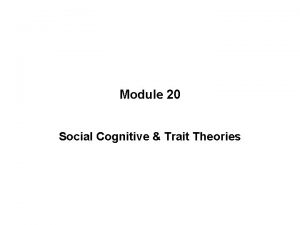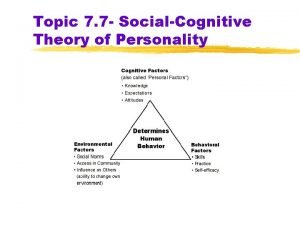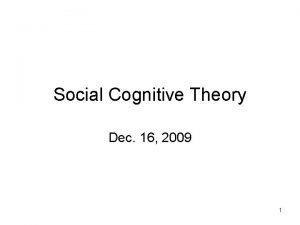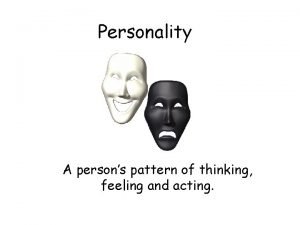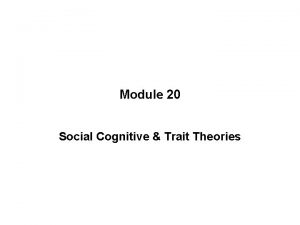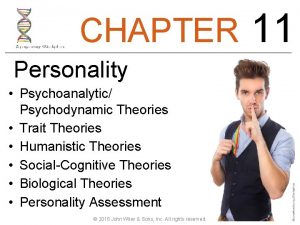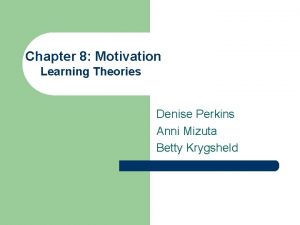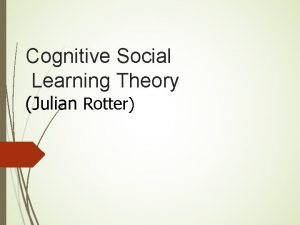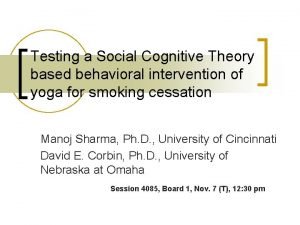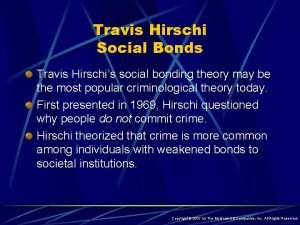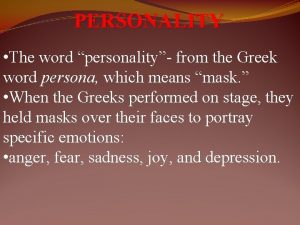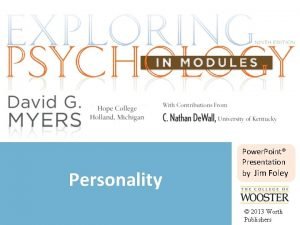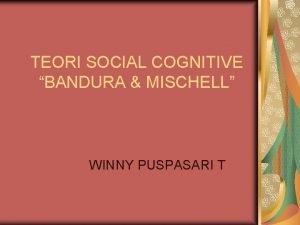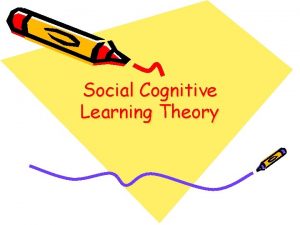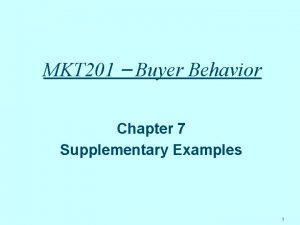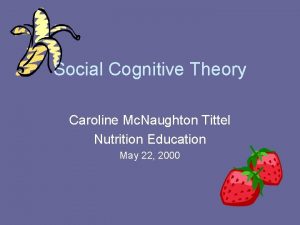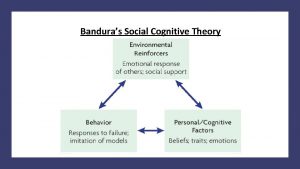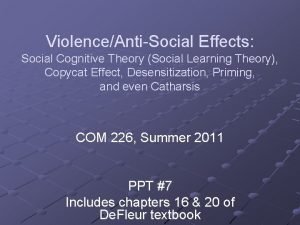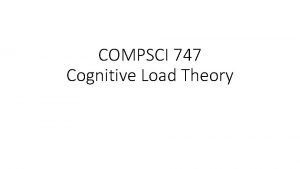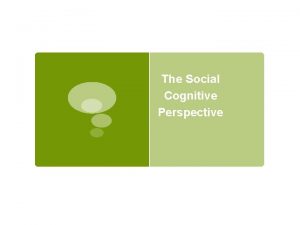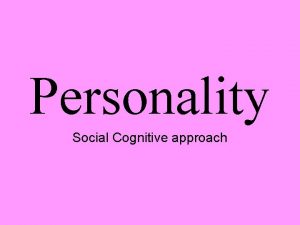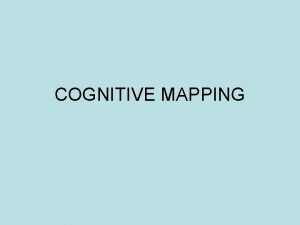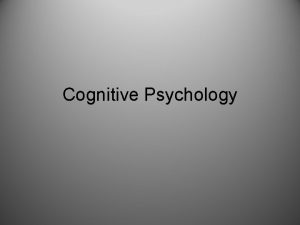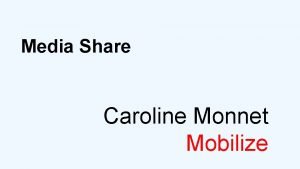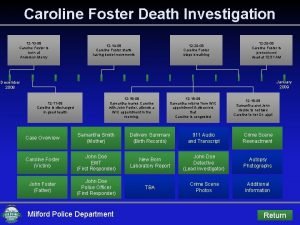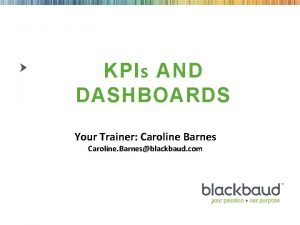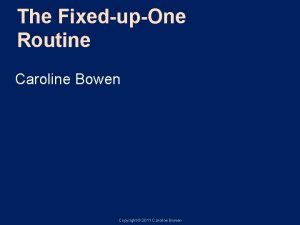Social Cognitive Theory Caroline Mc Naughton Tittel Nutrition
























- Slides: 24

Social Cognitive Theory Caroline Mc. Naughton Tittel Nutrition Education May 22, 2000

Social Cognitive Theory Mischel & Bandura • SCT addresses – Psychosocial dynamics influencing health behavior – Methods of promoting behavior change • Self-efficacy, self-confidence, and outcome expectations • Reciprocal determinism – Behavior, personal factors & environment all interact

Reciprocal Determinism Bandura Person Environment Behavior

Relevance of SCT to Health Education • Comprehensive – Cognitive, emotional & behavioral explanations of behavior • Constructs provide avenues for behavioral research & health education practice • Application of theoretical ideas developed in other areas of psychology to health behaviors & behavior

Constructs of SCT Mischel & Bandura • Environment • Situation • Behavioral capability • Expectations • Expectancies • Self-control • Observational learning • Reinforcements • Self-efficacy • Emotional coping responses • Reciprocal determinism

Use of SCT in Nutrition • Predicting Influences – “Social cognitive model of fruit and vegetable consumption in elementary school children” -Resnicow K et al – “Social-cognitive predictors of fruit and vegetable intake in children” -Reynolds KD et al – “Examination of specific nutrition/health behaviors using a social cognitive model” -Lewis CJ et al • Interventions – “Gimme 5 fruit, juice, and vegetables for fun and health: Outcome evaluation” -Baranowski T et al – “Development and evaluation of an intervention program: “Control on campus” -Wdowik MJ et al – “Changing fruit and vegetable consumption among children: The 5 -a-Day Power Plus program in St. Paul, Minnesota” Perry CL et al

Beverage Consumption • Extent to which milk & soda consumption behaviors are influenced by SC variables has not been examined • Justification – Current health concerns – consumption behaviors can be measured accurately – comparisons b/t whole/low-fat/skim & regular/diet soda Lewis et al (1989) J Am Diet Assoc; 89: 194 -202

Study Design Lewis et al • Written questionnaire mailed in 2 phases – Phase 1: 39 items frequency of consumption, knowledge, attitudes & behavior as well as demog – Phase 2: 59 items differential association, social and non-social reinforcement, behavior modeling • 457 adults mean age of 47 y, 58% female • 709 college students mean age 21 y, 50% female

Model for Food Frequency Consumption Behavior modeling Frequency of food consumption behavior Differential Association Evaluative Definitions Social Reinforcement Non-social reinforcemen Lewis et al

SCT Variables Lewis et al • Differential association – perceptions of family, friends, health experts, media • Attitude – “milk is important” & “soda is acceptable” • Social reinforcement – positive feelings, belonging, pleasing others • Nutrition knowledge – “true” & “false” & “don’t know”

SCT Variables Lewis et al • Behavior modeling – frequency by mother, father, other adult, significant other, friend, & favorite media star • Behavioral commitment – selection of beverages low in fat & sugar • Taste enjoyment – “not at all” (1) to “very much” (5)

Results Lewis et al • For both groups and for all 4 beverages, neither social reinforcement nor behavior modeling directly influence FOBC • Milk – taste enjoyment, commitment, attitudes toward importance directly related to FOBC for both groups & both whole & low-fat/skim – taste enjoyment related to commitment & attitude

Results Lewis et al • Soda – more variable than milk for consumption b/t groups & type of beverage – taste enjoyment & commitment were directly related to FOBC for both groups & both regular & diet

Conclusions Lewis et al “Best predictor of behavior is the person’s intention to perform the behavior” “Nutrition knowledge. . . may help to create an intervening variable, ‘behavioral intention, ’ which in turn leads to the actual behavior” “. . . social beverages. . . more variable & easily changed. . . healthful beverages. . . steady & deeply rooted”

Gimme 5! • Multi-component randomized school intervention in 4 th and 5 th graders to FJV consumption • Levels of FJV consumption in children range from 1. 9 to 2. 5 servings – thru the elementary school years • Focus groups conducted to determine environmental, personal & behavioral factors Baranowski et al (2000) Health Education & Behavior;

Gimme 5! Baranowski et al • 8 matched elementary school pairs • 6 -week intervention (12 sessions) – conducted by trained teacher – transparencies, handouts, worksheets, posters & weekly newsletters – Taste testing of snacks prepared by FSP – MTV-like video – Role-playing skits – Point-of-Purchase education

SCT Variables Baranowski et al • Environment – availability & accessibility • Behavioral capability – asking skills, Fa. SST recipes • Outcome expectancies – performance w/o acceptance by peers • Self-control – Goals for FJV at meals & snacks

SCT Variables Baranowski et al • Observational Learning – teacher, parents (? ) • Reinforcement – prizing for completing assignments, congratulations • Self-efficacy – Role-play to bolster asking & shopping skills • Reciprocal determinism

Results Baranowski et al • 1, 172 students provided 7 -d food records for 3 y – 15% African American, 85% Euro-American • Curriculum implementation was 47% for all activities, w/ only 22% of crucial activities performed • participation in video & POP education activities • Effect size of 0. 2 servings comparable to other interventions

Results Baranowski et al

Future Directions Baranowski et al • Better understanding of food choice • More effectively impact mediating variables & processes • Explorations of alternatives channels • Teacher training which results in higher curriculum fidelity • Higher dose of several intervention components

Control on Campus Abstract from Wdowik et al (2000) Diabetes Educ; 26(1): 95 -104 • Based on SCT and EHBM • Type I Diabetes knowledge, attitudes & behaviors assessed pre-, post- & at followup – 3 intervention cohorts, 1 control – Reporting of Hb. A 1 C & knowledge significantly for intervention groups – More support on campus, overcame fears associated with BG testing, frequency of BG testing, testing when BG felt to be low

Limitations of SCT • Too many constructs • Limited in its ability to predict behavior • No significant behavior seen in large intervention studies • Applied to a single behavior or not • Additional influences • Fails to address nonlinearities

References • Baranowski T et al. (2000) Health Education and Behavior; 27(1): 96 -111. • Elder JP. Motivating Health Behavior. New York: Delmar, 1994. • Glanz K. Health Behavior and Health Education: Theory, Research and Practice. San Francisco: Jossey-Bass, 1997. • Lewis CJ et al. (1989) J Am Diet Assoc; 89: 194 -202. • Perry CL et al. (1998) Am J Pub Health; 88(4): 603609. • Resnicow K et al. (1997) Health Psychology; 16(3): 272 -276. • Reynolds KD et al. J of Nutr Edu; 31(1): 23 -30.
 Social cognitive personality
Social cognitive personality History of forensic psychology
History of forensic psychology Protocolo naughton
Protocolo naughton Naughton & wilson
Naughton & wilson Social cognitive personality
Social cognitive personality Social cognitive theory motivation
Social cognitive theory motivation Social cognitive theory of personality examples
Social cognitive theory of personality examples Social cognitive theory of personality examples
Social cognitive theory of personality examples Social cognitive personality
Social cognitive personality Social cognitive theory motivation
Social cognitive theory motivation Freedom of movement rotter
Freedom of movement rotter Social cognitive theory
Social cognitive theory Cognitive and non cognitive religious language
Cognitive and non cognitive religious language Social thinking and social influence in psychology
Social thinking and social influence in psychology Social thinking social influence social relations
Social thinking social influence social relations Social bond and social control theory
Social bond and social control theory Social cognitive approaches to personality
Social cognitive approaches to personality Social cognitive personality
Social cognitive personality Personality in greek word
Personality in greek word Social cognitive approaches to personality
Social cognitive approaches to personality Teori social cognitive
Teori social cognitive Scribbr
Scribbr Bandura's reciprocal determinism
Bandura's reciprocal determinism Cognitive dissonance theory example
Cognitive dissonance theory example Cognitive learning theory by jerome bruner
Cognitive learning theory by jerome bruner
